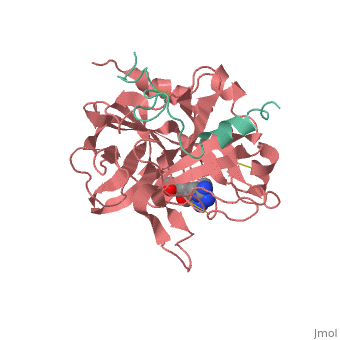Serine protease
From Proteopedia
Ailie McGregor (Talk | contribs)
(New page: <applet load="1ppb" size="450" color="white" frame="true" align="right" spinBox="true" caption="Human Thrombin with PPACK inhibitor" /> '''Serine proteases''', so called due to the prese...)
Next diff →
Revision as of 17:13, 29 December 2007
|
Serine proteases, so called due to the presence of a serine residue in the active site, are a class of enzymes that catalyse the hydrolysis of peptide bonds in proteins.
Thrombin
Thrombin is a "trypsine-like" serine protease. Its structure is shown here with a peptide chloroketone inhibitor (PPACK). The thrombin A chain (cleaved N terminal fragement) is shown in cyan and the B chain is shown in grey. The is made up of a catalytic triad of Ser195, His57 and Asp102, backed up by Ser214. The peptide chloroketone inhibitor (PPACK) is shown covalently attached to Ser195. A closeup shows the at which the sidechain of Asp194 makes a salt link with the N-terminus at residue 16, newly formed when the A chain is cleaved in the zymogen-to-enzyme activation process. The specificity pocket is on one side of the throat of the domain 2 beta barrel, and the activation site is close next to it.
The B chain consists of two domains. As is true for all of the "trypsin-like" serine proteases, each of the two thrombin domains consists mainly of a 6-stranded, antiparallel beta barrel. The specificity pocket (here filled with the Lys sidechain of the PPACK inhibitor) is in one side of the throat of the domain 2beta barrel, and the activation site is close next to it.
Proteopedia Page Contributors and Editors (what is this?)
Michal Harel, Ailie McGregor, Alexander Berchansky, Ann Taylor, Harry Greenblatt, Eran Hodis, Jaime Prilusky

